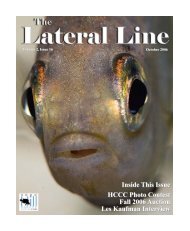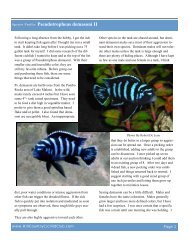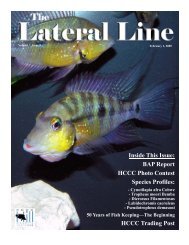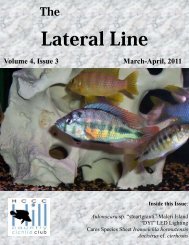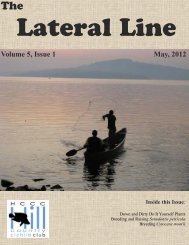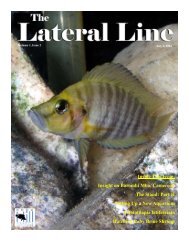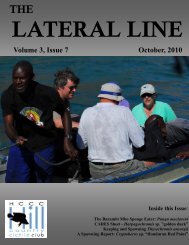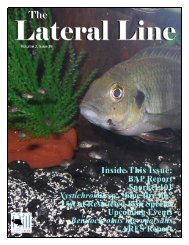Haplochromis sp. flavenentis.pub - Hill Country Cichlid Club
Haplochromis sp. flavenentis.pub - Hill Country Cichlid Club
Haplochromis sp. flavenentis.pub - Hill Country Cichlid Club
You also want an ePaper? Increase the reach of your titles
YUMPU automatically turns print PDFs into web optimized ePapers that Google loves.
Species Profile: <strong>Haplochromis</strong> <strong>sp</strong>. "<strong>flavenentis</strong>"<br />
I had the opportunity in 2003 to discuss with one of the<br />
worlds most famous fish collectors, Heiko Bleher, one<br />
of his amazing finds. Years earlier I had seen a photograph<br />
of a beautiful cichlid in his Lake Victoria collection<br />
deemed <strong>Haplochromis</strong> <strong>sp</strong>. "46". Heiko was good<br />
enough to carry on an email exchange with me that<br />
centered on his collection exploits in and around the<br />
Lake Victoria region. One of the recurring topics I<br />
managed to slip into our corre<strong>sp</strong>ondence was this colorful<br />
little cichlid he called <strong>sp</strong>ecies 46. When we finally<br />
met face to face, Heiko again entertained me with collecting<br />
tales and was able to give me a little more information<br />
on this <strong>Haplochromis</strong> I so badly wanted to include<br />
in my collection. Heiko explained to me that this<br />
fish was abundant in and around papyrus roots at the<br />
water's edge. The locale was the Yala Swamp region<br />
bordering Uganda and Kenya in the Northeast portion<br />
of Lake Victoria. I was told that he shipped a sampling<br />
of mostly unidentified cichlids<br />
to an exporter in Germany.<br />
This is where his collected<br />
<strong>sp</strong>ecimens of <strong>Haplochromis</strong> <strong>sp</strong>.<br />
"46" had been sent as well.<br />
Heiko's photograph that<br />
<strong>sp</strong>arked my interest was taken<br />
in this exporters holding tank.<br />
In the course of further tracking<br />
down this amazing cichlid,<br />
I learned that a shipment containing<br />
six <strong>Haplochromis</strong> <strong>sp</strong>.<br />
"46" had been sent to the US.<br />
This is where the trail went<br />
cold. The only other information I was able to gather<br />
was that all remaining individuals of the cichlid I<br />
sought had been lost in Germany.<br />
As years passed by, I never forgot about my holy grail,<br />
the elusive <strong>Haplochromis</strong> <strong>sp</strong>. "46". I pondered if there<br />
was still a wild population, or like so many other cichlids<br />
from this region, they had been lost forever.<br />
One afternoon in 2004, I got a call from Dave<br />
Photo by Greg Steeves<br />
Schumacher, a good friend of mine, that a locale<br />
wholesale importer had a cichlid I would likely be interested<br />
in. Dave pointed out to me a small haplochromine<br />
labeled <strong>Haplochromis</strong> <strong>sp</strong>. "polli". Dave<br />
thought that this fish resembled in many ways Heiko's<br />
photograph of the <strong>sp</strong>ecies 46. I did not think this to be<br />
so and much discussion and research ensued. The<br />
"polli" turned out to be a wonderfully beautiful cichlid<br />
that bred true. Dave and I have both been successful in<br />
propagating this mystery <strong>sp</strong>ecies. While photographically<br />
documenting my colony, I happened to snap a<br />
shot that made me stare in awe. I had photographed a<br />
polli in the same position that Heiko had captured his<br />
<strong>sp</strong>ecies 46 in, years before. The similarities were too<br />
numerous not to notice. Coloration, body markings,<br />
and e<strong>sp</strong>ecially dorsal pigmentation appeared nearly<br />
identical. I had little basis to draw a conclusion that<br />
the <strong>Haplochromis</strong> <strong>sp</strong>. "46" and <strong>Haplochromis</strong> <strong>sp</strong>.<br />
"polli" were one in the same<br />
besides the two photographs.<br />
I had no dentition, scale embedment,<br />
or gut analysis to<br />
compare. Neither fish had<br />
been described. I am thoroughly<br />
convinced that the two<br />
fish in question are one in the<br />
same. In an attempt to di<strong>sp</strong>el<br />
confusion we refer to this<br />
seemingly unknown fish as<br />
<strong>Haplochromis</strong> <strong>sp</strong>.<br />
"<strong>flavenentis</strong>". This correlates<br />
to the golden yellow coloration<br />
the cichlid exhibits. Fishbase recognizes a <strong>Haplochromis</strong><br />
polli (Thys van den Audenaerde 1964) type<br />
locale Stanley Pool, Congo, later described as Ctenochromis<br />
polli (P. H. Greenwood 1979) but <strong>sp</strong>ecies descriptions<br />
do not conform to our cichlid.<br />
Aquatic requirements of <strong>Haplochromis</strong> <strong>sp</strong>.<br />
"<strong>flavenentis</strong>" are not unlike many other Lake Victoria<br />
www.<strong>Hill</strong><strong>Country</strong><strong>Cichlid</strong><strong>Club</strong>.com Page 1
Species Profile: <strong>Haplochromis</strong> <strong>sp</strong>. "<strong>flavenentis</strong>"<br />
haplochromines. My breeding group of three males and four females are housed in a 55 gallon<br />
tank. As with most cichlids, the larger quarters you can provide for them, the more comfortable<br />
they will be. <strong>Haplochromis</strong> <strong>sp</strong>. "<strong>flavenentis</strong>" enjoy rockwork and are mildly territorial.<br />
One male will establish<br />
dominance and di<strong>sp</strong>lay more<br />
vibrant coloration than his con<strong>sp</strong>ecifics.<br />
The dominant male<br />
will lure gravid females to his<br />
loosely held territory by body<br />
shaking with all fins fully extended.<br />
Colors <strong>sp</strong>arkle from the<br />
dorsal when exposed to bright<br />
light. Numerous dry runs are<br />
made before the female begins<br />
dropping eggs. The female<br />
quickly turns to pick up her eggs<br />
and mouths at the male's occuli.<br />
Photo by Greg Steeves<br />
With her brood fertilized, the female<br />
retreats to quiet area of the tank in incubate her larvae. At 80 F the fry have absorbed<br />
their yolk sac and are free swimming in 19 days. The dominant male is 11 cm while the females<br />
are 9cm. Brood sizes are between 20 and 30<br />
fry. <strong>Haplochromis</strong> <strong>sp</strong>. "<strong>flavenentis</strong>" is not at all picky<br />
in regards to diet. A good quality staple flake seems to<br />
provide ample nutrition for both growth and health. I<br />
supplement all my haplochromines with occasional<br />
treats of Cyclop-eeze.<br />
Photo by Greg Steeves<br />
www.<strong>Hill</strong><strong>Country</strong><strong>Cichlid</strong><strong>Club</strong>.com Page 2
Species Profile: <strong>Haplochromis</strong> <strong>sp</strong>. "<strong>flavenentis</strong>"<br />
I truly hope that enough serious hobbyists will work with <strong>Haplochromis</strong> <strong>sp</strong>. "<strong>flavenentis</strong>" that<br />
we may someday see it commonly in our aquaria. It would be a horrible loss if this beautiful<br />
little cichlid were to slip into obscurity once again.<br />
Photo by Greg Steeves<br />
— by Greg Steeves<br />
Hap. <strong>sp</strong>. 46— Used with permission from Heiko Bleher<br />
www.<strong>Hill</strong><strong>Country</strong><strong>Cichlid</strong><strong>Club</strong>.com Page 3



